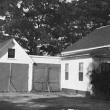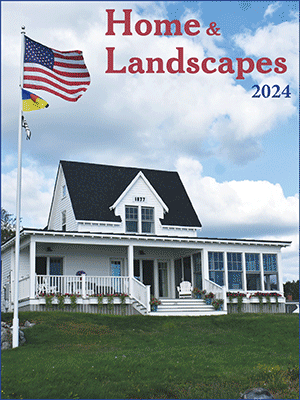Boothbay's post-war modernization
 This shot, from the 1961-1962 Boothbay Town Report, shows the south side of the 1848 town hall when it was still at Boothbay Center. The little addition is the 1885 town office. Behind is the small garage, large enough for a couple of vehicles, but not for the town's large snowplow/sand trucks, loaders or grader.
This shot, from the 1961-1962 Boothbay Town Report, shows the south side of the 1848 town hall when it was still at Boothbay Center. The little addition is the 1885 town office. Behind is the small garage, large enough for a couple of vehicles, but not for the town's large snowplow/sand trucks, loaders or grader.
 This shot, from the 1961-1962 Boothbay Town Report, shows the south side of the 1848 town hall when it was still at Boothbay Center. The little addition is the 1885 town office. Behind is the small garage, large enough for a couple of vehicles, but not for the town's large snowplow/sand trucks, loaders or grader.
This shot, from the 1961-1962 Boothbay Town Report, shows the south side of the 1848 town hall when it was still at Boothbay Center. The little addition is the 1885 town office. Behind is the small garage, large enough for a couple of vehicles, but not for the town's large snowplow/sand trucks, loaders or grader.
Recently a consultant for the Maine Department of Transportation came to the museum to look into various landmarks at Boothbay Center. One of them was the old town office and garage, situated on the west side of Route 27 just above Wylie Cemetery. The MDOT emissary told me she was given a building date of 1925 for it.
“That's just wrong,” I said. “My father drew the building's plans for the town in the late 1950s or early 1960s.” Fifty years is too soon to have things so out of whack. Though most lifelong or longtime residents with some age (like me) have a fair idea of when the building went up, some may like to read about the times and the changes.
Town managers
The post-war years pulled Boothbay toward a modern, "professional" approach in town matters, with emphasis on relatively expensive infrastructure and innovations. When the town's total valuation was $1,130,000 in 1947, Boothbay introduced the town manager system, a mixed blessing since the bred-in-the-bone local knowledge is diluted, while a professional with time and grade in other towns and a broad knowledge of standards and practices expands efficiency.
Boothbay's path was gradual with ex-selectman, Phil Blake, stepping in part-time for a few years. In 1951, the town turned to a professional out-of-towner, Preston King, as manager, and I believe that's been the case ever since.
Town managers often have short tenures. When Town Manager John Anderson and his wife Cathy Sherrill came to town in 2000, she and I quickly became good friends. Within a couple weeks she told me, "Town managers last about five years." The town was lucky that John, with his conscientiousness, decades of experience managing towns and excellent reputation among his New England peers, stayed 10 years.
Back in 1959, Claude Bransford became Boothbay's fifth town manager in 12 years, and he lasted five years, much longer than his predecessors, but matching Cathy's rule of thumb.
East Boothbay Water District
Bransford's years saw accelerated change. The East Boothbay Water District was formed in 1960, with my father one of the five local men on its board. When I was a child in the village, we had only summer water. In winter we relied on rain and melted snow from the roof, funneled by gutter to brick cisterns in the cellar.
Unreliable winter water could become a tense situation, requiring severe rationing and forethought. One two-inch-deep bath a week, with the same water reused by the four of us and warmed by teakettle, was not cozy. The bath water lived on further, bailed into buckets to flush the toilet when absolutely necessary.
While East Boothbay did have the greatest house density in town (and you need that density to be cost effective) now I wonder how other localities felt about our good fortune in gaining year-round water in the early 1960s.
Certainly the village shipyards were important to the town's bottom line, and horrific fires such as at Goudy & Stevens in 1944 and Hodgdon's in 1954 made you long for hydrants, so it's understandable. But the town had a good thing with that water, supplied by wells off the Beath Road. It won the statewide taste-test many years.
Also in this period, Boothbay still used a small town office that was built in 1885, a little bump-out off the south side of the town hall. I'm sure it served well for many decades with no manager and perhaps only part-time secretarial help. I remember volunteering with my mother to sort some town paperwork as a child. We set up on a long table in the town hall. Things were done in a grassroots, informal way back then. In my next column, I'll lay out the construction of the new town office and garage in 1961.
Event Date
Address
United States






















